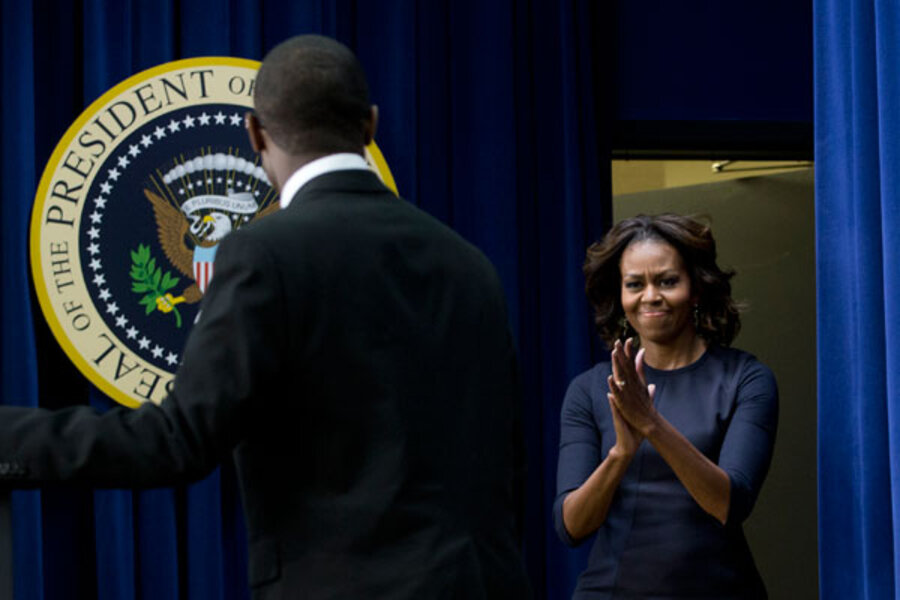Obamas host summit to help low-income students go to college
Loading...
President Obama brought together more than 80 higher education leaders Thursday for a White House summit on expanding college success for low-income students. The ticket for their entry: A public commitment to specific efforts in 2014 to forward that goal.
About 100 such initiatives were announced Thursday, and they should be the starting point of a long-term shift, the president said.
“We want to restore the essential promise of opportunity and upward mobility that’s at the heart of America,” Mr. Obama said. “If we as a nation can … reach out to [low-income] young people and help them not just go to college, but graduate from college or university, it could have a transformative effect.”
This “Call to Action on College Opportunity” is part of the administration’s larger push to make college more affordable, invest in higher education as an engine of economic mobility, and make the United States a world leader in the share of citizens earning degrees by 2020.
Without this push, economic mobility will be largely a myth, the administration argues. Only 9 percent of people born into the bottom quarter of incomes earn a bachelor’s degree by age 25, compared with 54 percent of those in the top quarter of incomes, the White House notes. Without college, the chance of moving from the bottom to the top of income brackets is minuscule.
The “story of opportunity through education is the story of my life,” first lady Michelle Obama said at the summit, telling about her own path to and through Princeton University as a first-generation college student. She plans to commit more time to reaching out to young people, because she wants them to “know it can be their story too.”
Colleges, universities, and higher education groups announced their commitments in at least one of four categories.
1. Help connect low-income students to the right schools
Research has shown that more than half of high-achieving, low-income students don’t apply to schools that are challenging and selective enough.
To help, the College Board and its member institutions will send information packets to every income-eligible student who takes the SAT college entrance test, as well as four waivers for college application fees.
More than 80 colleges and 15 organizations are taking action in this area, including boosting recruitment of low-income students and expanding financial aid.
Philanthropies are also stepping up their commitment. They announced new investments totaling $95 million to help more low-income students pursue degrees in the STEM fields (science, technology, engineering, and math). And the Posse Foundation, which gives students from diverse urban backgrounds full scholarships, doubled the number of STEM partner schools from five to 10.
The young man who introduced Mrs. Obama Thursday went from being illiterate at 14 to attending Bard College on a full scholarship, partly through the help of a mentoring program and Posse.
“I’m inspired and encouraged,” says Kathleen McCartney, president of Smith College, crediting the summit for being organized around concrete actions. “When you see the results of this work, it’s amazing.”
While colleges need to improve graduation rates, particularly for disadvantaged students, “We have to attack the myth that low-income kids cannot succeed in college,” said Daniel Porterfield, president of Franklin & Marshall College in Lancaster, Pa.
The Franklin & Marshall board decided to shift much of its aid away from merit aid to better support need-based aid, increasing its share of students on federal Pell Grants for low-income students from 5 percent to 17 percent in recent years. Among those lower-income students, 98 percent have persisted beyond their freshman year, Mr. Porterfield said.
2. Start low-income students preparing for college early
More than 30 colleges and a dozen groups have promised new action, such as tutoring partnerships between colleges and high schools, $12.5 million to support better STEM teaching, and a new $5 million effort to help students make the link between higher education and pathways to careers.
In California, the three branches of the higher education system – community colleges, state universities, and the University of California – will jointly reach out to seventh-graders in the state to encourage them to prepare for college and understand financial aid options.
3. Expand college advising and test preparation
Low-income students tend to attend schools with fewer counseling resources and have fewer peers and relatives who can help them navigate the application process. The National College Advising Corps has committed to reach out to an additional 80,000 students in the next three years, and other commitments include the expansion of programs in which current low-income college students advise high school and middle school students.
Khan Academy, largely known for its down-to-earth online tutorials for students of all ages, is developing new college-prep features and an advising section geared to the needs of high-potential low-income students.
4. Improve remedial college courses
Currently only 1 in 4 students in remedial classes eventually earn a community college degree, the White House notes. Twenty-two states are working with Complete College America to ensure that more students who need remedial help complete college-level English and math in their first year, gateway courses that have been shown to improve success rates.
Some advocates for low-income students are skeptical about how transformative the initiatives announced Thursdaycan be.
“While I have appreciated the efforts people and organizations have made to assist students from low income family backgrounds,… people are avoiding the central problem that poor people don’ t have enough money to pay for a college education,” says Tom Mortenson, a senior scholar at The Pell Institute for the Study of Opportunity in Higher Education in Washington. To expand opportunity, he said, maximum yearly Pell grants – from the federal government or perhaps a combination of federal, state, and institutional support – should be $15,000, he says, nearly triple the current maximum.








